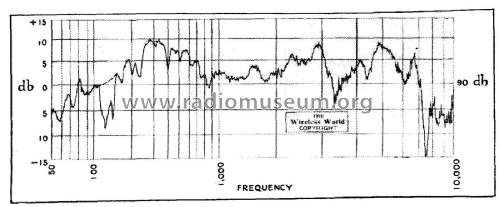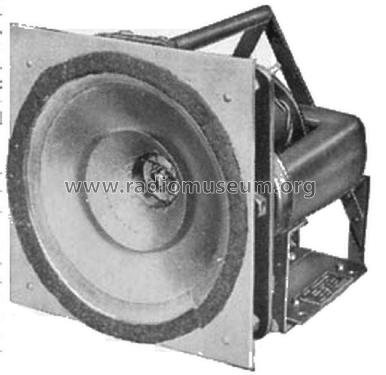Voigt Twin Diaphragm Driver Unit
Voigt Patents Ltd.; Sydenham
- Country
- Great Britain (UK)
- Manufacturer / Brand
- Voigt Patents Ltd.; Sydenham
- Year
- 1934
- Category
- Loudspeaker, headphone or earphone
- Radiomuseum.org ID
- 340352
- Main principle
- Audio-Amplification
- Wave bands
- - without
- Power type and voltage
- Direct Current supply (DC)
- Loudspeaker
- Electro Magnetic Dynamic LS (moving-coil with field excitation coil)
- Material
- Various materials
- from Radiomuseum.org
- Model: Voigt Twin Diaphragm Driver Unit - Voigt Patents Ltd.; Sydenham
- Shape
- Chassis only or for «building in»
- Notes
-
Voigt Twin Diaphragm Driver Unit.
Voigt was granted British patent 413758 in July 1934 for the design of this twin-cone diaphragm speaker which extended the upper-frequency range.
Review from Wireless World, March 29, 1935, Page 318.
This unit was tested on one of the original 4ft. Tractrix horns in which the sides were constructed of rather thin plywood.
As a result of the vibration of the sides of the horn, a depression appears in the curve between 100 and 200 cycles. This would not show in current models of the horn in which a greater thickness of wood has been employed.
Although the output shows a continuous decline below 100 cycles, the apparent cut-off of the horn is much lower, and the observer will estimate it at 70 cycles. Between 100 and 6,000 cycles the output remains constant for all intents and purposes between + or -3 dB.
Above 6,000 cycles the sound energy does not fall rapidly away as in the majority of loudspeakers but is maintained up to at least 10,000 cycles, although at a level of about 10 dB below the main part of the curve.Excellent as is the frequency response, however, the two features for which this loudspeaker is especially notable are the extremely high electro-acoustic efficiency and the excellence of the transient response. Both these features are attributable to the better air loading of the diaphragm and the high clamping of the field in which the flux density is of the order of 17,000 lines.
- Price in first year of sale
- 23.00 GB £
- Mentioned in
- Wireless World (The), London (WW, 79) (March 29, 1935, Page 318.)
- Author
- Model page created by Gary Cowans. See "Data change" for further contributors.
- Other Models
-
Here you find 6 models, 6 with images and 1 with schematics for wireless sets etc. In French: TSF for Télégraphie sans fil.
All listed radios etc. from Voigt Patents Ltd.; Sydenham
Forum contributions about this model: Voigt Patents Ltd.;: Voigt Twin Diaphragm Driver Unit
Threads: 1 | Posts: 1
Extracted from the Lowther Voigt Radio, Season 1936-37, Page 18.
Voight Twin Diaphragm Unit
Specifications
| Flux Density: | 16,000 to 17,500 gauss under working conditions |
| Magnet Gap: | 2mm |
| Field Consumption: | 40 watts approximately |
| Sound Power Output: | Estimated at 2 by 107 ergs/sec. for normal speech & music |
| Speech Coil Resistance: | 15-17 Ω (aluminium wire) |
| Dynamic Impedance: | 30-35 Ω at normal frequencies. |
| Speech Coil Choke: | Tapped, for tone control. |
| Weight: | 31 lb |
Very little can be said in the space available to describe fully all the various points and advantages of the Voigt moving coil driving unit. First and foremost, it is noteworthy that high electro-acoustic efficiency is believed to be between 25 and 35%, that is to say, that for a given input the sound output would be about 5 dB above the average unit.
Under working conditions across a 2 mm gap used N.P.L. tests reveal 17,000 lines per sq. cm.
In practice, with such an intense magnetic field, the inductance of the moving coil is substantially less when the field is switched on than when it is off.
As a result, the dynamic impedance at 8,000 cycles is only about 50 Ω which compares very favorably with an impedance of 30 to 35 Ω at normal musical frequencies.
This not only permits accurate matching with the output valve and also the maximum transference of electrical energy, but there will also be no tendency to choke back the higher harmonics.
To reproduce transients "aperiodically" that is, without delay introduced when the resonance of any kind is used to build up the vibration it is necessary that the currents should not be wasted in overcoming the inertia of the moving parts. Since the available force on the coil is partly used to overcome the inertia of moving parts, it will be obvious that by making the inertia as low as possible the maximum force will be left to do useful work.
In the Voigt Loudspeaker, this inertia is made as low as possible by using aluminium wire for the speech coil. There are, therefore. Three reasons why the efficiency of high notes is greater than with ordinary loudspeakers.
Two types of diaphragms are available the standard and the twin. The standard diaphragm responds efficiently up to above 4000 cycles.
The twin diaphragm is slightly different from the standard and in particular, is provided with a second truncated cone that deals with frequencies above 4000 cycles.
The Unit when fitted with normal diaphragms (standard or twin) and used on a suitable horn is intended to handle an input from a few milliwatts up to that required to produce sound output estimated at 2 by 107 ergs/sec. This, power is about half that of a nine to fifteen-piece jazz orchestra and owing to the high efficiency of the Voigt speaker is obtainable with an electric input of 6 to 8 watts.
Alternatively, when greater handling capacity is required, a unit fitted with a double power diaphragm may be used. Such a double power diaphragm is incorporated in the Protected Public address unit.
At very low frequencies, i.e. well below the horn "cut-off, the intense magnetic field helps to prevent excessive vibration of the coil. This is because the back E.M.F. produced by movement in the strong field opposes the current through the coil, thus reducing it.
Boominess in reproduction and danger of rattle or damage due to excessive displacement are thus avoided.
Gary Cowans, 04.Oct.22

